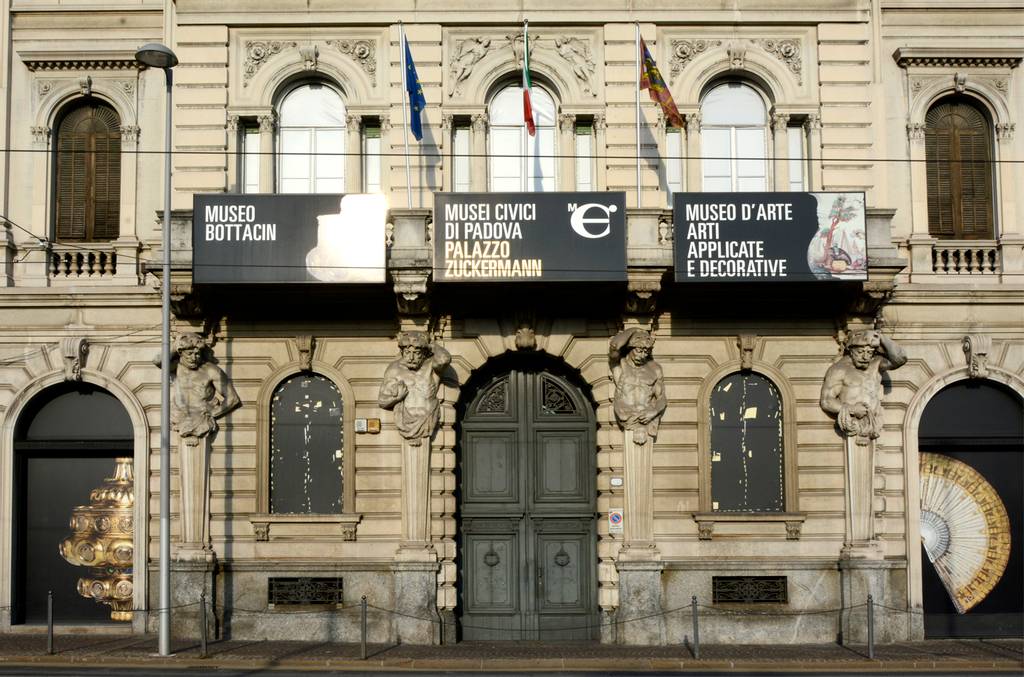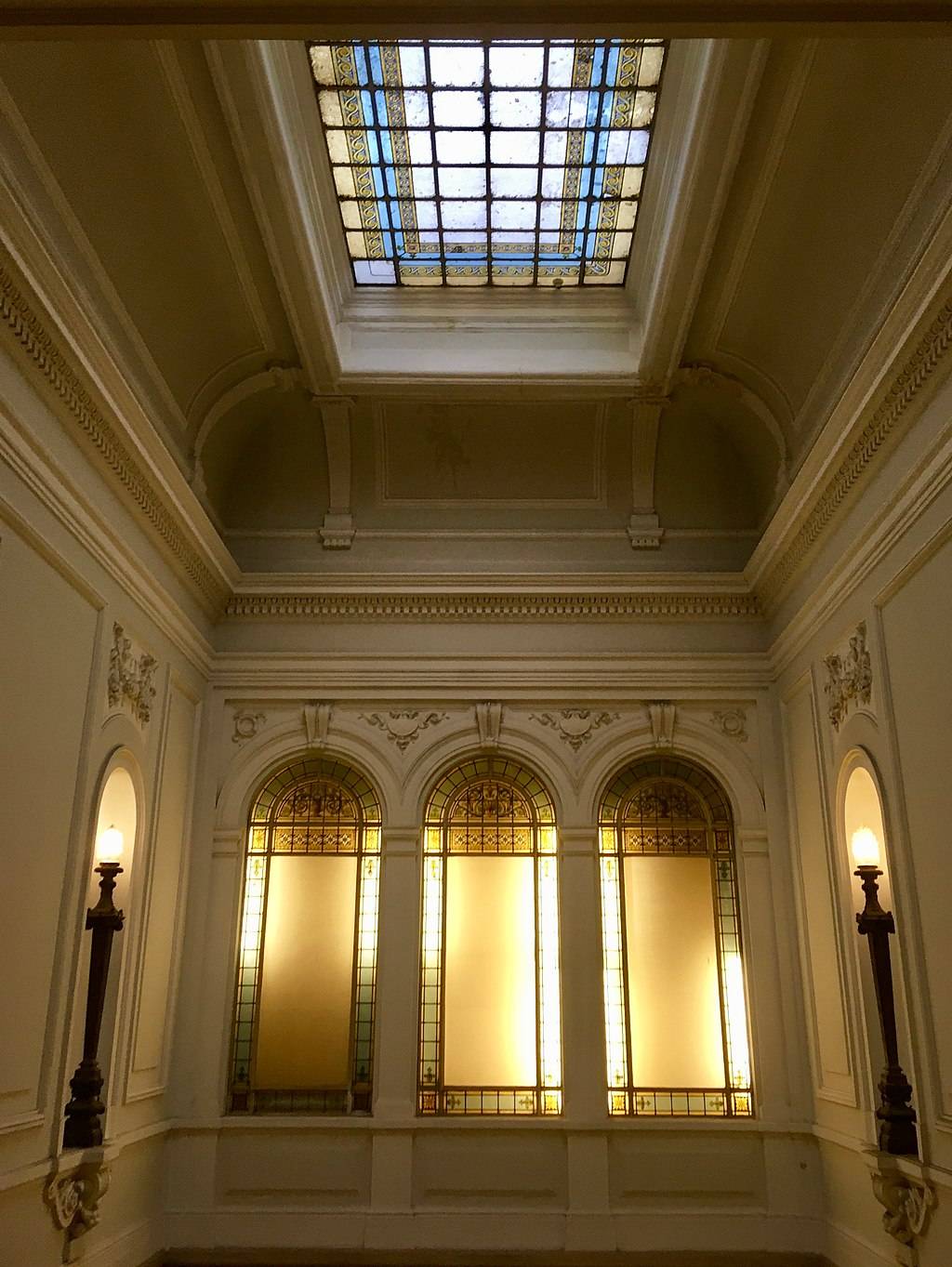Palazzo Zuckermann
Part of the Eremitani Civic Museums complex, the palazzo houses the Museum of Applied and Decorative Arts and the Bottacin Museum in its rooms.

Palazzo Zuckermann is an imposing twentieth-century building overlooking Corso Garibaldi. The palace is located in a richly historic area that includes the Roman Arena, the Scrovegni Chapel, the Church of the Eremitani and the Eremitani Civic Museums, a museum complex of which the palace has been part since 2005.
In the past, it housed the headquarters of Padua’s Post Office.
The palace, commissioned by the industrialist Enrico Zuckermann, was built between 1912 and 1914 on a project by the Milanese architect Filippo Arosio.
The neoclassical facade of the building has elements influenced by the Liberty style – the Italian version of Art Nouveau.
The beautiful internal courtyard on the ground floor incorporates some remains of the old city walls. It is called the Garden Theater of Palazzo Zuckermann and, during the summer, is home to numerous cultural events, such as classical and opera concerts and theatrical performances.
The main floor houses the Museum of Applied Arts, while the Bottacin Museum is located on the second floor.
Museum of Applied and Decorative Arts
The Museum of Applied and Decorative Arts houses a vast collection of handicraft works made as early as the Middle Ages. The collection consists of ceramics, majolica, antique furniture, men's and women's clothing, and embroidery.
Of particular interest are the collections of sixteenth-century ceramics from Urbino, Pesaro and Venice, such as the remarkable porcelain coffee service produced by the manufacturer Cozzi in 1792.
One section is dedicated to the jewellery collections donated to the museum by private individuals: in 1883, Leone Trieste donated his collection of men's jewellery, consisting of rings, tie pins, watch chains and seals, and in 1917 Adele Sartori Piovene donated his precious collection of rings and brooches in French and English style.
The various exhibition rooms also present paintings and tombstones of particular interest, as well as some decorations and fragments of the historic church of San Martino, one of the suppressed ecclesiastical institutions at the beginning of the nineteenth century.
The itinerary ends with a small but refined collection of oriental art objects collected in the nineteenth century by collectors and enthusiasts.
Bottacin Museum
The Bottacin Museum, on the other hand, houses a vast collection of ancient coins, furniture, sculptures and manuscripts.
The museum takes its name from Nicola Bottacin, a wealthy Trieste merchant who in 1865 generously donated to the municipality his heritage of art and ancient coins collected in the first half of the nineteenth century.
The museum's collections were later expanded with subsequent purchases and donations. Today the Bottacin Museum is an essential point of reference for numismatics experts all over Europe, with a collection of more than 100,000 ancient and modern coins.
The entrance to the museum is decorated with a bust by Angelo Cameroni and a portrait of Agusto Caratti dedicated to Nicola Bottacin. The rest of the exhibition is organised along two paths, one regarding the works of art and the other one devoted to numismatics.
The first path encompasses a rich collection of works of art that have furnished Bottacin's residence or were acquired later. There are furniture and furnishings, a collection of ancient weapons, manuscripts, nineteenth-century paintings made mainly by Venetian artists, and sculptures, including the bust of Doge Paolo Renier made by Antonio Canova. Particularly valuable are the Nuremberg Cup, a work created in 1534 by the German goldsmith Melchior Baier, and the Graduale Malaspina, an illustrated parchment music manuscript from the 13th century.
The second itinerary is entirely dedicated to the history of money. This section makes the Bottacin Museum one of the most prestigious numismatic institutes in Europe. The Collection is arranged in chronological succession throughout the two rooms.
The first room regards the Greek coinage and its influence over the Celtic currency, Roman republican and imperial issues, and the continuity of Byzantine money. The exhibition starts from the origin of coins, which took place in Lydia in 580 B.C. and continues until the fall of the Roman Empire. It displays Athenian offerings dating back to the sixth century BC, gold staters from the period of Alexander the Great, and Roman coins such as golds, denarii, and sesterces from the time of Caesar Augustus. Among the most interesting pieces are the very rare Roman medallions of the Emperors Hadrian, Septimius Severus, and Maxentius.
A second room collects coins minted in medieval and modern times, with particular attention to Venetian coins, such as coins from the Venetian series that is one of the richest and most complete in the world, and a golden duchy of Francesco I da Carrara, the only one in possession of a public institute.
The history of the Italian currency is also presented, from the mints of the Venetian area, the Renaissance silver thaler and gold scudo, up to the paper money of the eighteenth century, the Italian lira and the current currency, the Euro.
Finally, the Museum is equipped with a rich library, which contains more than 25,000 volumes of numismatics and the complete collections of the leading sector magazines, a collection of prints by prestigious authors, such as Rembrandt, Giambattista Tiepolo and Albrecht Durer and an illustrated album of the seventeenth century, called the Bottacin Code, which depicts the Venetian feasts, costumes and ceremonies of the time.
We welcome all contributions, no matter how small. Even a spelling correction is greatly appreciated.
All submissions are reviewed before being published.
Continue to changelog-

© 'Palazzo Zuckermann' by Gianni Sinigaglias is licensed under CC BY-SA 4.0 Attribution copied to clipboard Failed copying attribution to clipboard -

© 'Lo scalone del Museo di Palazzo Zuckermann a Padova' by Marco Chemello is licensed under CC BY-SA 4.0 Attribution copied to clipboard Failed copying attribution to clipboard -

© 'Lo scalone del Museo di Palazzo Zuckermann a Padova' by Marco Chemello is licensed under CC BY-SA 4.0 Attribution copied to clipboard Failed copying attribution to clipboard -

We welcome all contributions.
All submissions are reviewed before being published.
We welcome all contributions, no matter how small. Even a spelling correction is greatly appreciated.
All submissions are reviewed before being published.
Continue to changelogWe welcome all contributions, no matter how small. Even a spelling correction is greatly appreciated.
All submissions are reviewed before being published.
Continue to changelogWe welcome all contributions, no matter how small. Even a spelling correction is greatly appreciated.
All submissions are reviewed before being published.
Continue to changelogCategory
Cost
-
113 m
The Scrovegni Chapel houses one of the most outstanding masterpieces of figurative art of all time, the complete fresco cycle created by Giotto
-
The Roman Arena of Padua was an amphitheatre used for gladiator games in the ancient Patavium. The Arena ruins are now part of the Giardini dell'Arena park.
-
168 m
The most important Paduan complex of museums features the Archaeological Museum and the Museum of Medieval and Modern Art in a charming former convent.
-
179 m
The church, partially destroyed in 1944, preserves the remains of the splendid frescoes painted by Guariento and Andrea Mantegna
-
In Padua, the pedestrian streets from the city centre are known as Liston, an area extending from Piazza Garibaldi all along to Prato della Valle.




